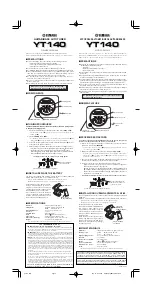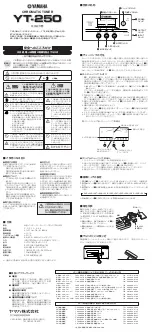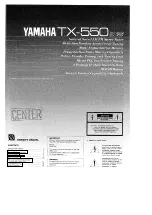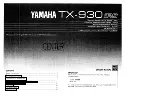
HOW TO TUNE THE INSTRUMENT
■
AUTO/MANUAL mode
Tune the instrument according to the indication of the tuning meter on the liquid crystal
display.
1. To tune an electric instrument, connect its output cord to the input jack
.
2. Press the power button
to turn on the tuner.
3. Select the tuning mode. Press the selector button
to select “MODE”. Press UP
or DOWN
button to select “AUTO” or “MANUAL” tuning mode.
4. If you have selected “MANUAL” mode, select the note you wish to tune.
Press the selector button
to select “NOTE”. Press UP
or DOWN
button
to set the desired note.
5. To change the reference pitch, press the selector button
to select “PITCH”. Press
UP
or DOWN
button to set the desired frequency.
6. For transpositon tuning, press the selector button
to select “ KEY”. Press UP
or DOWN
button to set the desired key.
7. Play the instrument to give a note. When tuning an acoustic instrument, bring it as
close as possible to the built-in microphone
.
8. Tune the instrument until the LED at the center of the tuning guide
lights up in
green and the pointer of the tuning meter
stays in the center (“0” position).
To tune the instrument more accurately, tune it further until the cent indication
reaches “0”.
[Flat]
[In tune]
[Sharp]
■
SOUND mode
The tuner gives out the note you wish to tune.
1. Press the power button
to turn on the tuner.
2. Select the tuning mode. Press the selector button
to select “MODE”. Press UP
or DOWN
button to select “SOUND” tuning mode.
3. Select the note you wish to tune.
Press the selector button
to select "NOTE". Press UP
or DOWN
button to
set the desired note.
4. To change the reference pitch, press the selector button
to select “PITCH”. Press
UP
or DOWN
button to set the desired frequency.
5. For transposition tuning, press the selector button
to select “ KEY ”. Press UP
or DOWN
button to set the desired key.
6. Tune the instrument on the basis of the reference note the tuner produces.
●
Precautions on tuning
1. The tuner may pick up noise from the surrounding environment or the hum noise
generated by electric appliances, and shows indications as if a note is played. This
is not a malfunction, and the tuner operates properly when a note is played.
2. To tune acoustic instruments, the note is received through the built-in microphone.
It is recommended, therefore, that the tuning procedure be performed in a quiet
environment for accurate tuning. Also, bring the instrument close to the tuner to
register a note. If it is difficult to tune the instrument with the built-in microphone, it
is recommended that a microphone, such as SEIKO STM-20, sold separately from the
tuner, be used together with the tuner.
MEMORY BACKUP FUNCTION
Even after the tuner is turned off, the following settings are stored in memory and will not
be erased. The descriptions in the parentheses represent the initial settings made at the
factory. If the batteries are replaced with new ones, the tuner will return to the initial settings.
1.
Setting item
[MODE]
2.
Tuning mode
[AUTO]
3.
Reference pitch
[440 Hz]
4.
Note
[A]
5.
Key
[C]
BATTERY CHANGE
●
When the batteries near their end, the liquid crystal display will become dim. In that case,
replace the batteries with new ones immediately. If the batteries are exhausted, the tuner
may not operate properly.
●
When replacing the batteries, replace both of them with new ones at the same time. It
is recommended that batteries of the same manufacturer and of the same type be
installed.
1. While pressing the battery hatch, slide it in the
direction of the arrow until it stops, and lift it to
remove.
2. Install two AAA dry batteries (R03 or LR03),
checking the + and – terminals are properly
aligned.
* If the batteries are set with their terminals improperly
aligned, it may result in a malfunction.
●
If you decide not to use the tuner for a long time, be
sure to remove the batteries from the tuner.
* When disposing of the batteries, observe the regulations of the
authorities concerned.
CAUTION ON USING THE TUNER
If the power button
is not pressed properly, or if the battery change procedure is not
performed properly, the tuner may malfunction. In that case, press the power button
to
turn off the tuner immediately. Then, press it again, and check if the tuner operates properly.






















